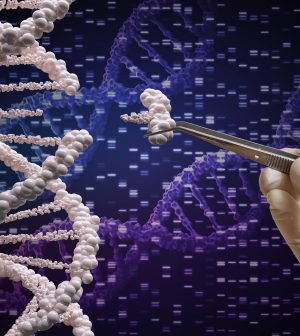- Understanding the Connection Between Anxiety and Depression
- How Daily Prunes Can Influence Cholesterol and Inflammation
- When to Take B12 for Better Absorption and Energy
- Epsom Salts: Health Benefits and Uses
- See What Saffron Can Do for Sleep and Heart Health
- 6 Common Mistakes to Avoid Before Your Physical
- Can Sweating Really Help You Beat a Cold?
- Strengthening Your Relationship: Practical Strategies
- Skip Storing This Everyday Product in the Fridge Door
- Green Tea + B3 Pairing May Boost Brain Health
Mutant Gene Stops At-Risk People From Getting Alzheimer’s: Could It Lead to Treatment?

The APOE4 gene is the most powerful genetic factor driving a person’s risk for developing late-onset Alzheimer’s disease.
“It probably increases your risk two or threefold if you have one APOE4 copy, and if you have two APOE4 copies, it probably increases your risk about tenfold,” said Dr. Michael Greicius, a professor of neurology at Stanford Medicine.
But that story just became a little more complicated — in a way that could potentially save the brains of millions who’ve inherited the APOE4 gene.
An international research team led by Greicius has discovered a rare mutation that actually negates the Alzheimer’s risk posed by the APOE4 gene.
The R251G variant changes just a single amino acid in the apolipoprotein E (APOE) gene, but that simple alteration appears to neutralize the Alzheimer’s risk normally caused by APOE4, researchers said.
Unlike most people with APOE4, people with the R251G mutation have no increased risk of developing Alzheimer’s, according to a Stanford news release.
“Maybe 1 in 1,000 people who carry that high-risk gene also carry on the same copy of the gene a protective variant that essentially takes the high risk and cuts it,” Greicius said.
This discovery could help untangle the 30-year-old mystery of why APOE4 is such a powerful risk factor for Alzheimer’s, Greicius said.
The first studies linking APOE4 to the degenerative brain disease came out in the 1990s, but no one yet has figured out how the gene actually increases risk.
“It won’t take much for basic scientists to insert this exact same genetic variant into a cellular model and ask how APOE behaves differently with this variant in it,” Greicius said, adding that lab researchers also could insert the R251G variant into mice.
“The mouse models take a couple of years to breed and to age, but all of that should be done a lot more quickly now,” Greicius said. “So I’m really excited to sort of spread the word and have some of my basic science colleagues in the field really dive into the mechanism.”
Heather Snyder, the Alzheimer’s Association vice president of medical and scientific relations, agreed that “the exact role of APOE is not well-understood in Alzheimer’s.
“The idea that there are additional variants of APOE that may mitigate risk of Alzheimer’s is very interesting,” Snyder said. “Better understanding this biology is highly important so that we can gain insights from these new variants that may translate into possible targets for therapies.”
For this study, published in May 31 issue of the journal JAMA Neurology, Greicius and his colleagues mined huge sets of genetic data that included more than 544,000 people. These included gene analysis of more than 67,000 people with Alzheimer’s, 28,000 people who have an immediate family member with Alzheimer’s, and 340,000 healthy people to compare them against.
Everyone carries a version of the APOE gene, which mainly helps manage the use of cholesterol around the body, Greicius said. Cholesterol is important for normal cell function, as a key ingredient in cell walls.
“We think that the normal function of APOE has a lot to do with shuttling cholesterol between cells both in the brain and also in the rest of the body,” Greicius said.
Like all genes in the body, people inherit two copies of APOE from their parents.
The most common version of the gene, APOE3, doesn’t influence a person’s risk of Alzheimer’s at all. Another called APOE2 actually protects against Alzheimer’s.
And then there’s APOE4.
About 25% of people with European ancestry have one copy of APOE4.
Analyzing all that genetic data, the researchers discovered that the R251G variant appeared to reduce the Alzheimer’s risk of people who had inherited APOE4.
“What’s really exciting about the new variant, R251G, is that it is always co-inherited with APOE4,” Greicius said. “This is something that in people who are at higher risk because of having APOE4 reduces their risk.
“It basically shows that nature has come up with a way through genetics of mitigating the APOE4 risk,” Greicius said.
Even more interesting is where R251G affects the APOE4 gene, he added.
The proteins produced by APOE4 have two main pieces, one part that binds to proteins and another part that binds to cholesterol, Greicius said.
“This new protective variant we’re describing here is actually on the part of the protein that binds to lipids like cholesterol or other fats,” Greicius said. “It’s in a distinct region of the protein APOE4.”
The research team also looked at second protective mutation that reduces Alzheimer’s risk by about 60%, the study reports. That variant, called V236E, is co-inherited with the common APOE3 gene, and provides a level of protection similar to that of APOE2.
“If we can better understand how the mutations are mitigating risk, this may open the door to possible treatment targets and/or biology to target for therapy development,” Snyder said.
More information
The U.S. National Institutes of Health has more about the genetic risks for Alzheimer’s disease.
SOURCES: Michael Greicius, MD, professor, neurology, Stanford Medicine, Palo Alto, Calif.; Heather Snyder, PhD, vice president, medical and scientific relations, Alzheimer’s Association; JAMA Neurology, May 31, 2022
Source: HealthDay
Copyright © 2026 HealthDay. All rights reserved.










